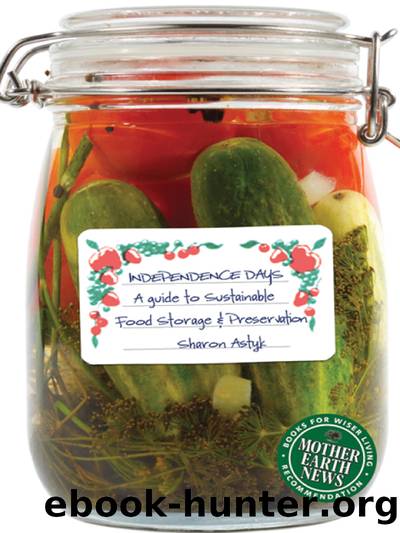Independence Days by Sharon Astyk

Author:Sharon Astyk
Language: eng
Format: epub
Tags: HOM022000
ISBN: 9781550924404
Publisher: New Society Publishers
Published: 2009-10-31T16:00:00+00:00
Root Cellaring
The term “root cellaring” is something of a misnomer. You see, most of us probably don’t have a root cellar attached to our house. At best we have a basement. If you are like me, and live in an old house with a basement that floods once in a while, your basement isn’t a very appealing place to think of sticking your food. So you may dismiss the idea of root cellaring out of hand.
That would be a shame because a surprisingly large number of people have some space where they can store food in its natural state. And that’s all that root cellaring actually is. Root cellaring is finding a way to mimic the natural conditions that some foods store well in. You may end up keeping your food in a basement, but you shouldn’t limit yourself to that.
So what conditions do food require? Well, it depends on the food. The basics of root cellaring involve taking a hard-shelled or very dense fruit or vegetable that naturally has a good storage life, and keeping it very cool. For most foods (there are a couple of important exceptions) the closer you can get to just above freezing the better. More realistically, most root cellars will vary by 10 or 15 degrees over the course of the year. For example, our “root cellar” is actually an unheated porch that doesn’t freeze. By November it is usually cool enough to keep most root cellared vegetables. We store them in bins, bags and boxes out on that porch. On really cold nights, we add blankets for extra insulation, and they do fine. We do not, however, achieve the perfect root cellar temperatures, so it helps that we choose good storage varieties.
Pumpkins, squash and sweet potatoes actually like warmer temperatures in the high 50s to low 60s, that is, the temperatures all of us conserving people keep our houses at anyway. So pumpkins, squash and sweet potatoes can go right in the house with you — in the cupboard, under the guest bed or in a convenient closet. Just don’t forget they are there. Even apartment dwellers can preserve these foods — you just find a spot and put them there. What kind of preservation could be easier?
Onions and garlic like conditions quite dry but cool. Your attic in the winter is probably too dry for good storage of apples and potatoes, but it might be just perfect for your onions and garlic. Just watch out for those unseasonable warm spells.
Where else might you find space? Well, what about outside? In cold climates many crops can be pulled up and left in trenches or holes in the ground, and then covered with a thick (several feet in my climate) layer of hay, straw or leaves. Straw bales laid over the trenches are perfect. You may get mice or other critters occasionally, but often things survive fairly well.
You can dig a hole and bury a wood or metal barrel, an old cooler, an old fridge or freezer in the ground and then cover the top with straw or leaves or hay to insulate it.
Download
This site does not store any files on its server. We only index and link to content provided by other sites. Please contact the content providers to delete copyright contents if any and email us, we'll remove relevant links or contents immediately.
Turbulence by E. J. Noyes(7039)
The Thirst by Nesbo Jo(5785)
Gerald's Game by Stephen King(3918)
Be in a Treehouse by Pete Nelson(3212)
Marijuana Grower's Handbook by Ed Rosenthal(3118)
The Sprouting Book by Ann Wigmore(3052)
The Red Files by Lee Winter(2914)
The Remains of the Day by Kazuo Ishiguro(2618)
Sharp Objects: A Novel by Gillian Flynn(2445)
Christian (The Protectors Book 1) by L. Ann Marie(2394)
Organic Mushroom Farming and Mycoremediation by Tradd Cotter(2307)
The Culinary Herbal by Susan Belsinger(2061)
Stone Building by Kevin Gardner(1995)
The Starter Garden Handbook by Alice Mary Alvrez(1924)
Lilac Girls by Martha Hall Kelly(1872)
The Unlikely Pilgrimage of Harold Fry by Rachel Joyce(1836)
The Lean Farm Guide to Growing Vegetables: More In-Depth Lean Techniques for Efficient Organic Production by Ben Hartman(1784)
Urban Farming by Thomas Fox(1749)
Backyard Woodland by Josh VanBrakle(1587)
